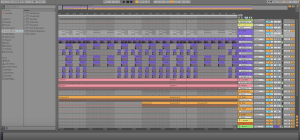House music is captivating and can inspire you in many ways, whether it’s the drums, vocals, or synth.
Despite being a relatively new genre, there’s a lot to explore. Don’t be intimidated by the instruments and samples – producing house music is more approachable than you think. Once you master the fundamentals, it’s all about your artistic vision.
Let’s examine the basics of house music production so you can develop your skills and create your unique sound.
What exactly is house music?
House music is a genre of electronic dance music. It originated in Chicago in the 1990s. Early house producers were inspired by disco music. They used TR-808 and TR-909 drum machines to clock and sequence synths like the TB-303 and DX7, as well as samples like the MPC2000. These tools were initially designed for musical practice but ultimately led to the development of a groundbreaking new genre of electronic music. The history of house music remains captivating and still influences modern producers to this day.
What do you need to create house music?
House music today is primarily created with DAWs like GarageBand, Logic, Ableton or FL Studio. Producers often use samples and drum machines to create loops that can be easily arranged in the DAW timeline or clip view. All you need to start producing house music is a computer with a DAW, instrument, effects plugins and samples.
What components make up a house song?
There are a few general guidelines for making the various elements of a house track stand out and sound good.
Typically, a house track comprises five fundamental elements:
- A four-on-the-floor kick
- Hi-hats and claps
- Synth bass
- Synth pads
- Synth leads.
Thus, it is wise to start brainstorming ideas, sound design, and arrangement for each of these elements whenever starting to compose a house track.
7 Steps to Making House Music
1. Begin with the drums
Although there are no strict rules dictating where to begin, music producers often recommend starting with the drums since they form the rhythmic foundation of a track. House drums commonly feature a few basic patterns, including four-on-the-floor kicks, claps on the backbeat, and offbeat hi-hats.
You can effortlessly construct this type of beat by inputting the drum parts in your DAW’s timeline using a MIDI roll to trigger your drum sampler or drum rack. Once you have a simple house drum beat arranged, you essentially have a blank slate to work with.
2. Include synth bass
If you liken the drums to a canvas, the bassline is like the outline of a painting for a producer.
Basslines provide both rhythm and tone, creating counter rhythms and ostinatos in a track while defining its key and chord progression.
Taking time to think through the bassline and arrangement can help to stimulate creativity. Experiment by recording a bassline into your DAW with a MIDI keyboard, then return to the MIDI roll to move notes around and explore various motifs.
Ensuring your bassline is engaging and danceable will help when composing the other elements of your track.
3. Add pads and a lead
Maintaining the Bob Ross painting analogy once again, pads are like the broad brushstrokes of color that a landscape painter uses to form the background, while lead synths are where producers add intricate details with fine brushes.
These components play a significant role in shaping the chord progression, harmony, and even the melody of your track.
It’s a common practice for producers to use smooth pads to create swirling chords in the background while employing punchy leads to provide melody and direction to the track. This technique can be particularly effective in crafting a memorable and engaging house music piece.
4. Layer all
Utilizing multiple sounds is crucial in producing music.
Incorporating various sounds for each instrument allows for more experimentation with sound design, panning, and arrangement.
Moreover, layering enhances the impact of the instruments, particularly with percussive instruments like hi-hats and claps.
After writing the MIDI for synths and drums, duplicating the parts and testing out different synths or drum sounds will expand the range of your music.
5. Experiment with the subtractive arrangement
When starting to write your track, aim to be a maximalist by including all the elements you want to have at the peak of your song. Begin by constructing an eight-bar section that includes your complete drum, bass, lead, and pad synths, along with any other elements you plan to have in the climax of your track. Once everything is built up, extend the loop to the desired length of your song. Now, the fun begins with the subtractive arrangement. By cutting parts away, you can explore the intricacies of each section and generate new ideas as you uncover different facets of your overall concept.
6. Make an arrangement for a vocal sample
Arranging a longer vocal sample can be a useful technique for subtractive arrangement. Ideally, the vocal sample should be as long as the track itself.
Vocals are often the focal point of a song, as our brains are naturally drawn to them. By arranging the track around a vocal loop, you can create space for the vocals to shine.
For example, you can cut away a part of the arrangement to make way for an impactful lyric or bring back the full track during a bridge between vocal parts.
Simply listening to how your track interacts with the vocal part can inspire new ideas and reveal any gaps or weaknesses in your arrangement.
7. Sound design, mix, and master house like a pro
Mixing involves creating a proper space for each element of your track while prioritizing important parts, such as vocals or leads. House music heavily uses synths, bass, and kicks in the low end, so paying special attention to bass mixing is crucial. To keep the low-end clear for the bass, producers may need to high-pass certain percussion and synth instruments. Sound design techniques like using filters on synths and drums with automation lines can also be useful. Additionally, sidechain compression on pads to the kick drum can add bounce to synths.
Conclude
Making house music, like any form of art, is entirely up to your discretion. Of course, there are various formulas you can follow, such as the one described in this article. However, you don’t have to confine yourself to a set of regulations on how you should produce a track.
In fact, creating house music is all about the vibe you want to emit—excellent house music is more of a feeling than it is an electronic music style.
Therefore, listen to house music and discover what you enjoy. Take note of what the producers are doing, and apply that knowledge to your own compositions. Study what the pioneers did in the 90s, explore your favorite DJ’s music, and continue to listen to various genres of music—nothing is more inspiring.



